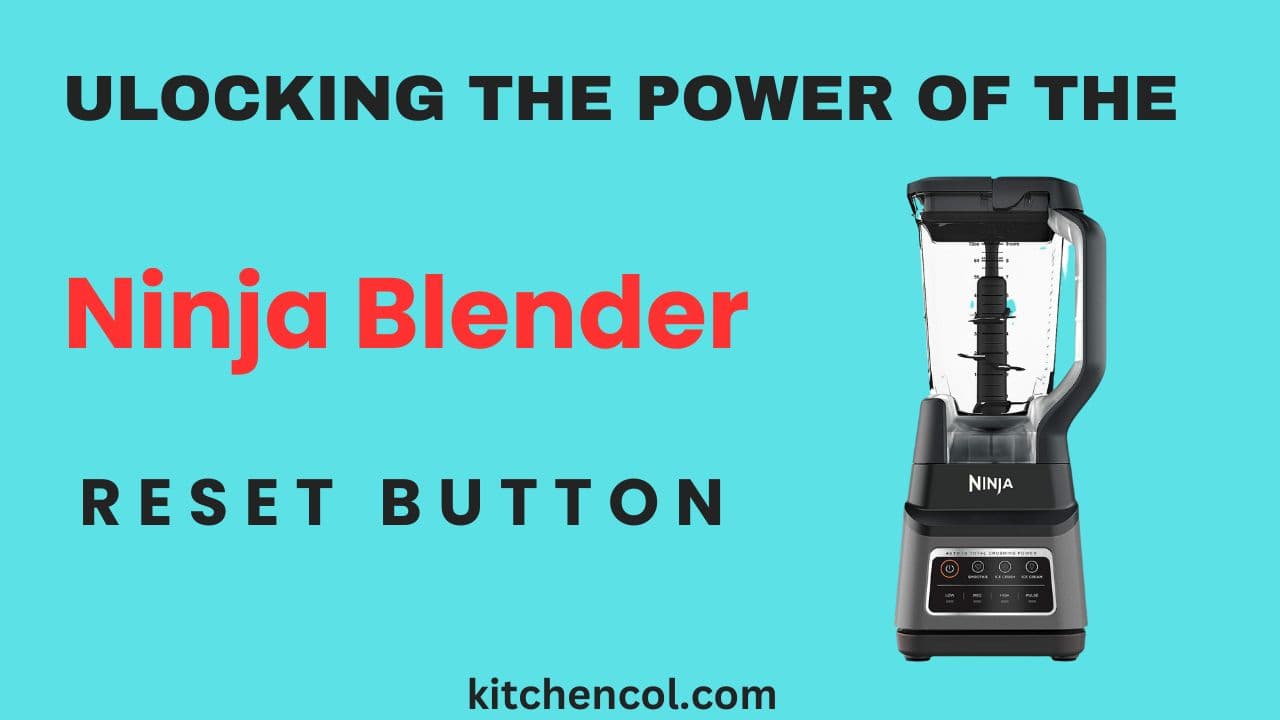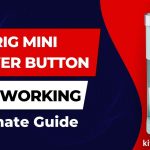In the world of kitchen appliances, the Ninja blender stands as a symbol of blending excellence. Known for its power and versatility, it has earned a spot in countless kitchens around the globe. However, even the mightiest of machines can sometimes encounter hiccups. That’s where the Ninja blender reset button comes into play, a little-known but vital feature that can save the day when things go awry.
In this blog post, we will unveil the mysteries of the Ninja blender reset button, exploring when and how to use it, as well as sharing valuable tips on preventing issues and troubleshooting beyond the reset button. Get ready to unlock the full potential of your Ninja blender as we dive into the world of this essential reset feature.
What is the Ninja Blender Reset Button?
The Ninja blender reset button is a small but crucial component found on most Ninja blender models. It serves as a reset mechanism designed to address certain issues that may arise during blending operations. Typically, this button is located on the base of the blender, usually near the power cord or underneath the appliance.
The primary purpose of the Ninja blender reset button is to safeguard the blender’s motor and electrical components from damage. It does this by allowing the blender to reset and recover from situations such as overheating, blade blockages, or power surges.

Here’s a closer look at what the Ninja blender reset button does:
- Overheating Protection: Blending dense or tough ingredients for an extended period can cause the blender’s motor to overheat. When this happens, the reset button can be used to shut down the blender temporarily. This break gives the motor a chance to cool down and prevent damage due to excessive heat.
- Blade Blockage Resolution: Sometimes, ingredients can become jammed in the blender’s blades, causing them to stall. The reset button can help dislodge these blockages by momentarily stopping and restarting the blender, allowing it to resume operation smoothly.
- Power Surge Recovery: In the event of a power surge or electrical issue, the Ninja blender reset button acts as a safety feature. It interrupts the blender’s operation, preventing electrical damage, and allows you to reset it once the power is stable.
Understanding how and when to use the Ninja blender reset button is essential for maintaining the longevity and efficiency of your blender. In the next sections of this blog post, we’ll delve deeper into when to use the reset button and provide step-by-step instructions on how to perform a reset effectively.
When to Use the Reset Button
Knowing when to use the Ninja blender reset button is crucial for ensuring the optimal performance and longevity of your blender. Here are common scenarios in which you should consider using the reset button:
Overheating Issues:
- Indicator Lights Flashing: If you notice that the blender’s indicator lights are flashing rapidly, it may be a sign of overheating. In this case, stop the blender immediately and use the reset button to initiate a cooldown period.
- Unusual Smells: If you detect unusual burning or overheating smells coming from the blender, it’s a strong indicator of overheating. Turn off the blender and use the reset button to allow the motor to cool down before attempting to blend again.
Blade Blockage:
- Blender Stalls or Vibrates Excessively: When blending, if you experience the blender stalling, vibrating excessively, or making unusual noises, it may indicate a blade blockage. In such cases, use the reset button to temporarily stop the blender and clear any obstructions from the blades.
Power Surges:
- Sudden Power Outages or Surges: If your blender experiences a sudden power outage or surge while in operation, the reset button can help protect the appliance’s electrical components. After a power issue, use the reset button to restart the blender once the power stabilizes.
Unresponsiveness:
- Blender Becomes Unresponsive: In some cases, the blender may become unresponsive or non-functional due to a temporary glitch. Using the reset button can help reboot the blender’s internal electronics and restore normal operation.
Blinking Lights:
- Blinking Indicator Lights: If the blender’s indicator lights are blinking or flickering unexpectedly, it may indicate an issue with the blender’s electronics. Using the reset button can often resolve these minor glitches and restore normal functioning.
Remember that the reset button is designed to address temporary issues and provide a safeguard for the blender’s motor and electrical components. If you encounter persistent problems even after using the reset button, it may be necessary to explore further troubleshooting steps or contact Ninja’s customer support for assistance.
In the next section of this blog post, we will provide step-by-step instructions on how to perform a reset using the Ninja Blender reset button.
How to Perform a Reset
Performing a reset on your Ninja blender is a straightforward process that can help address various issues, including overheating and blade blockages. Here’s a step-by-step guide on how to perform a reset using the Ninja blender reset button:
Unplug the Blender
- Before initiating a reset, ensure that the blender is unplugged from the power source. This step is crucial for safety.
Wait for a Specified Amount of Time
- The duration you should wait before proceeding to the next step may vary depending on your Ninja blender model and the issue you’re facing. Typically, a wait time of 1-2 minutes is sufficient to allow the blender’s motor to cool down or reset its internal electronics. Consult your blender’s user manual for specific guidance on the waiting time required for your model.
Plug the Blender Back In
- After the waiting period, plug the blender back into a stable power source. Make sure the power cord is firmly attached.
Press and Release the Reset Button
- On the base of your Ninja blender, look for the reset button. It is usually a small, recessed button near the power cord. Press and release the reset button. You may hear a click or feel a slight resistance when you press it.
Test the Blender
- Once you’ve pressed the reset button, your Ninja blender should be reset and ready for use. Test it by turning it on and blending as usual. Pay attention to any signs of improvement, such as reduced noise or smoother blending.
Monitor the Blender
- While using the blender after the reset, keep an eye on its performance. Ensure that it operates smoothly and without any unusual sounds or smells. This will help you confirm that the reset resolved the issue.
It’s important to note that the specific instructions for performing a reset may vary slightly depending on your Ninja blender model, so always refer to your blender’s user manual for model-specific guidance.
Additionally, if the problem persists even after performing a reset, or if you encounter a different issue, you may need to explore further troubleshooting steps or contact Ninja’s customer support for assistance.
Regular maintenance and proper usage can also help prevent the need for frequent resets and ensure your Ninja blender operates optimally.
Preventing the Need for a Reset
Preventing the need for frequent resets on your Ninja blender is not only convenient but also extends the lifespan of your appliance. Here are some tips and practices to help you avoid common issues that may necessitate using the reset button:
Regular Cleaning and Maintenance:
- Clean your Ninja blender thoroughly after each use. Disassemble the blender and wash the removable parts, such as the pitcher, blades, and lid. This prevents residue buildup that can lead to blade blockages.
Avoid Overloading:
- Follow the manufacturer’s guidelines for ingredient quantities. Overloading the blender can strain the motor and lead to overheating or blade blockages. When blending, start with smaller quantities and gradually increase if needed.
Proper Ingredient Preparation:
- Chop or cut ingredients into smaller, manageable pieces before adding them to the blender. This reduces the strain on the blades and motor, promoting smoother blending.
Use Recommended Recipes:
- When using your Ninja blender, stick to recipes and instructions provided in the user manual or on Ninja’s official website. This ensures that you’re using the blender for its intended purposes and prevents unnecessary stress on the appliance.
Steady Power Supply:
- Plug your blender into a stable power source, preferably a grounded outlet. Avoid using extension cords or power strips, as they can lead to power fluctuations that may trigger the need for a reset.
Blending Duration:
- Avoid running the blender continuously for extended periods. If you need to blend for an extended time, pause the blending process intermittently to allow the motor to cool down.
Monitor Blade Performance:
- Check the blades periodically for any signs of wear or damage. Damaged blades can lead to inefficient blending and may increase the risk of overheating.
Proper Assembly:
- Ensure that all blender components, including the pitcher, lid, and blades, are correctly assembled and securely in place before use. An improperly assembled blender may not function correctly.
Avoid Ice or Frozen Items:
- If your blender is not specifically designed for crushing ice or handling frozen items, avoid using it for these purposes. Ice and frozen items can strain the motor and increase the risk of overheating.
Regular Inspections:
- Check the plug and power cable on a regular basis for any signs of wear or damage. If you notice any issues, replace or repair them promptly to prevent electrical problems.
By following these preventive measures and practicing proper blender maintenance, you can minimize the need for using the reset button and enjoy smooth, trouble-free blending with your Ninja blender for years to come.
Troubleshooting Beyond the Reset Button
If you’ve tried using the Ninja blender reset button but are still facing issues, it’s time to explore troubleshooting options beyond this simple reset. Here are some steps to consider:
- Check for Blockages: Ensure there are no remaining obstructions in the blades or pitcher. Fully disassemble and clean the blender components to eliminate any potential blockages.
- Inspect the Power Supply: Verify that the power outlet is functioning correctly. Try plugging the blender into a different outlet to rule out electrical issues.
- Examine the Power Cord: Look for any obvious damage, such as fraying or exposed wires, on the power cord.
If you notice damage, replace the cord immediately. - Contact Customer Support: If the problem persists, reach out to Ninja’s customer support for guidance. They can offer detailed troubleshooting instructions or suggestions for potential fixes.
- Warranty Coverage: If your Ninja blender is still under warranty, check if the issue is covered. Ninja may offer repair or replacement options for eligible products.
- Professional Repair: If the blender is no longer under warranty and you cannot resolve the issue, consider consulting a professional appliance repair service for diagnosis and repair.
Remember that proper maintenance, cautious usage, and following manufacturer guidelines are key to preventing issues with your Ninja blender.
Also Read: How to Fix Cuisinart Air Fryer Toaster Oven Problems
Conclusion
The Ninja blender reset button is a valuable tool for addressing common issues such as overheating, blade blockages, and power surges. By understanding when and how to use it, you can extend the life and performance of your beloved kitchen appliance.
However, prevention is often the best course of action. Regular cleaning, responsible ingredient preparation, and following recommended recipes can significantly reduce the need for resets.
Should you encounter persistent problems even after using the reset button, there are further troubleshooting steps to explore. Checking for blockages, examining the power supply and cord, and reaching out to customer support are essential steps in resolving complex issues.
Ultimately, maintaining your Ninja blender in optimal condition ensures it continues to serve you with smooth, consistent blending results for years to come.
By combining the power of the reset button with preventative measures and effective troubleshooting, you can keep your Ninja blender at its peak performance, making it an indispensable tool in your kitchen arsenal.

My name is Manan Bukhari and I am an expert in reviewing kitchen products for years. I have a passion for testing multiple gadgets especially related to home & kitchen. I love to spend my free time in resolving issues if I face some in any of my daily use things. I have fixed multiple gadgets of my home on my own without any assistance and that thing gave me confidence to make a blog on troubleshooting of items that are for daily use to assist you folks. Even my wife praises me for having such talent. I always explore new machines on my own because this thing fascinates me.



